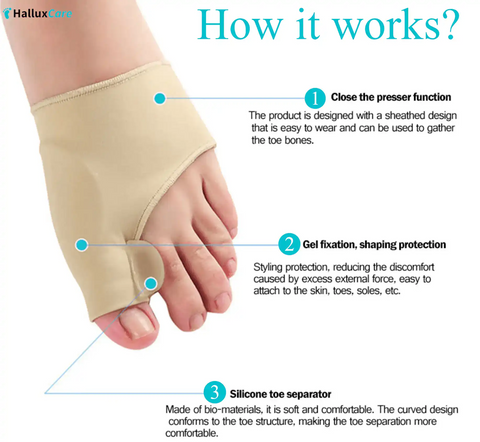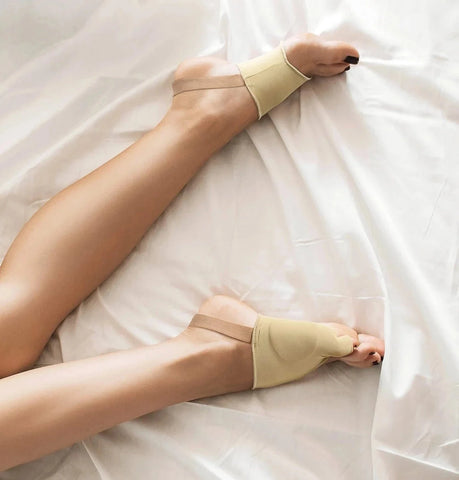Do I Have Bunions? Understanding the Pain Below Your Big Toe
Last Updated: April 2025 | Reviewed by Dr. Lisa Evans, DPM – Board-Certified Podiatrist
Disclaimer: This article is for informational purposes only and does not constitute medical advice. Always consult a licensed healthcare provider for diagnosis and treatment of any medical condition.
If you've ever felt a sharp ache or discomfort when wearing closed shoes—especially around the base of your big toe—you might be wondering, “Do I have bunions?” Bunion pain is a common concern, especially for those who love sneakers but dread the pressure they place on the sides of their feet. In this guide, we’ll break down what causes bunions, how to spot them early, and the most effective ways to ease the pain—without surgery.
What Are Bunions?
Bunions—medically known as hallux valgus—are bony protrusions that form at the joint where your big toe meets your foot. Over time, the big toe shifts inward toward the second toe, pushing the joint outward and creating the visible bump. Bunions are not just cosmetic—they can significantly impact mobility and cause chronic pain if left untreated.
According to the American Podiatric Medical Association (APMA), bunions are one of the most common foot deformities, particularly affecting women due to footwear choices like narrow, high-heeled shoes.
Common Symptoms of Bunions Include:
- Pain or soreness at the base of the big toe
- Swelling, redness, or inflammation
- A visible bulge at the side of the foot
- Trouble wearing certain shoes, especially closed-toe ones
- Numbness or burning sensation
The Reddit user’s experience of pain in covered shoes and a noticeable bulge is a textbook example of early-to-mid-stage bunion development.
4.9 ⭐⭐⭐⭐⭐ ( 1843 reviews )
Why You Shouldn’t Ignore That Toe Pain
A surprising number of people delay bunion treatment, thinking the issue will resolve on its own. However, bunions are progressive deformities. Without early intervention, the angle of your toe joint can worsen, leading to long-term complications.
Risks of Ignoring Bunion Pain:
- Permanent joint damage
- Reduced range of motion in the big toe
- Formation of painful corns and calluses
- Risk of developing osteoarthritis in the joint
According to the American Orthopaedic Foot & Ankle Society (AOFAS), early treatment can help avoid invasive procedures and long-term disability.
Simple Steps to Relieve Bunion Pain at Home
Not everyone wants to jump straight to surgery—and the good news is, many don’t have to. There are non-surgical, effective ways to manage bunion pain in your daily life.
✅ Try these bunion pain relief strategies:
- Wear Roomy Footwear: Look for shoes with a wide toe box and good arch support. Avoid narrow, pointed, or high-heeled shoes.
- Use Orthopedic Bunion Sleeves: These offer gentle alignment and cushioning throughout the day.
- Apply Cold Packs: Reduce swelling and pain by applying ice for 10–15 minutes after activity.
- Practice Foot Exercises: Toe stretches, marble pickups, and towel scrunches can help maintain joint flexibility and strength.
Top-Recommended Solution: Orthopedic Bunion Sleeves
Medical-grade bunion sleeves provide instant relief by redistributing pressure away from the bunion joint. They also promote alignment over time, making them an excellent option for day-to-day support.
If you're looking for relief from bunion pain, consider using the Orthopedic Bunion Pain Relief & Correction Sleeve, which provides support and helps to alleviate discomfort.
For additional protection, the Tailor's Bunion Bunionette Pain Relief Protection Sleeves are designed to offer comfort and protection for bunionette pain.
To nourish and soothe the skin around bunions, as well as to promote healthy hair, consider the Jamaica Black Castor Oil Soothing Oil. Known for its moisturizing and anti-inflammatory properties, it helps alleviate discomfort around bunions and supports hair growth and scalp health.
When to See a Podiatrist
If home remedies aren't cutting it, don’t wait. A podiatrist can assess the severity of your bunion using imaging and clinical exams, then recommend options like physical therapy, orthotics, or even minimally invasive surgery if needed.
Signs You Need Professional Help:
- Persistent pain, even when barefoot
- Difficulty walking or standing for long periods
- Noticeable worsening of the toe’s angle
- No relief from self-care or over-the-counter products
Key Takeaways
- Bunions are progressive: Treating them early can prevent deformity and pain.
- Look for symptoms: Pain, swelling, and a bump at the toe joint are early signs.
- Non-surgical relief is possible: Orthopedic sleeves, proper footwear, and exercises can help.
- Consult a podiatrist: If symptoms persist, professional evaluation is essential.
Practical Tips & Real-World Applications
- At Work: Keep a bunion sleeve in your desk drawer for long office days in closed shoes.
- At the Gym: Use wide-fitting sneakers and do toe stretches before and after workouts.
- At Home: Go barefoot when possible and use cold compresses after long days on your feet.
FAQs
Q: Are bunions hereditary?
A: Yes, bunions often run in families due to inherited foot structure. However, they can also be caused or worsened by poor footwear choices.
Q: Can bunions go away on their own?
A: No. Bunions are a structural deformity and will not resolve without intervention. However, early treatment can prevent them from getting worse.
Q: Do bunion sleeves really work?
A: Yes, when used consistently, bunion sleeves can reduce pain, improve alignment, and prevent progression. They are especially effective in the early stages.
Q: When is surgery necessary?
A: Surgery is considered when conservative treatments fail and the bunion causes significant pain or mobility issues. A podiatrist can help determine if it’s right for you.
Q: Are tailor’s bunions the same as regular bunions?
A: No. While similar, tailor’s bunions (or bunionettes) occur on the outside of the foot at the base of the little toe, rather than the big toe.
Final Thoughts: Don’t Wait Until It’s Too Late
If your shoes are causing foot pain—especially around the base of your big toe—it’s worth digging deeper. Bunions may start as a minor annoyance, but left unchecked, they can evolve into a major mobility issue. Act early, explore non-invasive options, and consult a podiatrist when needed. Your feet are the foundation of your body—take care of them.
Have you ever dealt with bunion pain? What strategies or products have helped you the most? Share your experience in the comments—we’d love to hear from you!
Disclosure: Some links in this article are affiliate links. We may earn a small commission if you make a purchase through these links, at no additional cost to you. All products mentioned are independently reviewed and recommended by medical professionals.




